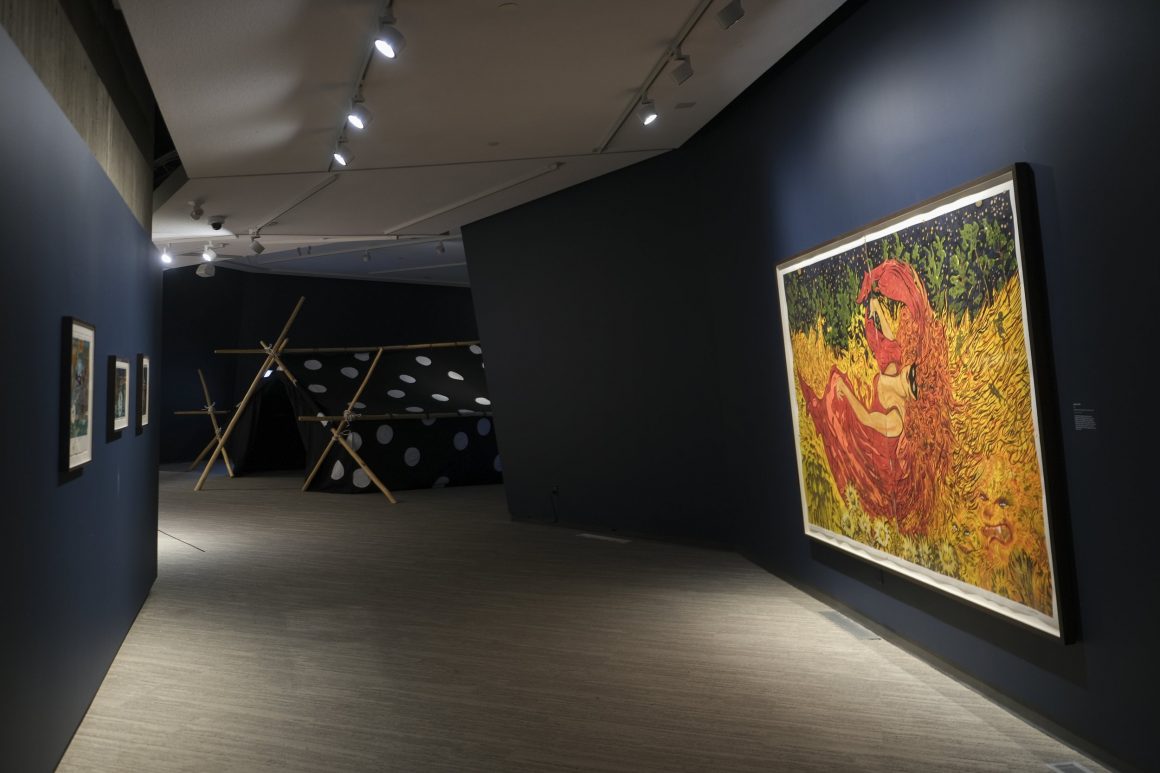
Review of Ghosts of Canoe Lake: New Work by Marcel Dzama at Contemporary Calgary
By Katelyn Liakos, September 26 2024—
Contemporary Canadian artist Marcel Dzama returns with Ghosts of Canoe Lake, exploring Canadian landscapes, memories, and climate change through playful, evocative art. I had the opportunity to visit Dzama’s exciting new collection last Sunday.
The show is housed in a circular gallery with dark blue walls, and the exhibition text is illuminated at the entrance. A gallery assistant advised me to begin by going to the right, as “it will make more sense that way,” upon my entry. I would recommend the same to anyone seeing this exhibition—you’ll gain more from the experience if you do a bit of homework. By this, I mean thoroughly reading the exhibition texts and taking the time to observe the paintings long enough to notice patterns and recurring characters. Dzama’s work invites viewers to explore a rich world of folk narratives and a recurring cast of characters, creating a narrative that evolves throughout his practice.
Don’t expect to be guided too closely through the show—Dzama leaves much up to the audience to piece together these narratives. Whether the artist asks too much of his audience is open to debate, but it’s something to keep in mind when engaging with his work. The exhibition features a collection of new paintings created in the past year, as well as a selection of video works from throughout Dzama’s career.
The show begins with smaller, vibrant watercolor paintings, layered with glittering acrylic. Dzama’s playful, childlike style blends humor with seriousness. His detailed works feature recurring characters like polka-dotted figures and masked individuals. Though intimate pieces draw viewers in, the immersive large-scale works are the exhibition’s highlight.
The first large piece, Dzama’s triptych After the Fire, Before the Flood (2023) portrays a dystopian landscape of floods and wildfires—tragically familiar disasters. While environmentalism is a theme throughout Dzama’s work, it’s especially immersive here. The vibrant, glitter-laced patterns contrast with the sadness of destroyed homes. It evokes thoughts of recent Canadian environmental devastation, raising questions about whether Dzama’s characters are victims or bear responsibility for nature’s retaliation.
As we continued through the show, I stumbled upon my favorite painting: Lady of Fire (2023), a huge diptych portraying the Canadian wildfires as a red-haired woman in a crimson dress dancing through a forest, setting it ablaze. The figure is playful, appearing to enjoy herself as the forest burns around her. Though the painting was made with the 2023 wildfires in mind, it’s hard not to think of the recent Jasper wildfires this past summer. Wildfires have become a constant and destructive presence in our lives—both life-altering and strangely beautiful, much like the woman in the painting. Are we, like Dzama’s whimsical characters, partly to blame for these disasters? Or is the earth reclaiming the land we’ve taken?
While these reflections filled my mind with a mix of sadness and appreciation for the painting’s beauty, my thoughts were interrupted by a bizarre video piece. This video, featuring characters from the paintings, appeared to be a dance video akin to a late-night show sketch. It was silly and outlandish, and akin to campish internet art. I couldn’t help but laugh when one character stopped the dance midway to yell at the others, demanding they start over. This video diverged sharply from the tone of the rest of the work—an unexpected moment of pure humor.
Halfway through the gallery, I encountered a large polka-dotted tent containing one of the few video works in the show. Surrounding the tent are video projections, and on the outside, there’s a large sculpture of the moon, reminiscent of the 1902 black-and-white short film Le Voyage Dans La Lune. As my companion and I entered the tent, we were greeted by a black-and-white video, also styled like films from the time. We whispered and pointed out characters from the paintings we had just seen, trying to piece together the story, but our speculation was abruptly halted when one character’s head violently exploded—though in a strangely childlike manner. We exited the tent, feeling slightly shaken but intrigued.
In the end, I can’t say with confidence that I fully grasp everything Dzama is trying to convey. However, I don’t believe that detracts from the experience. Dzama’s work is both inviting and challenging, playful and absurd, melancholic and occasionally startling. If you’re willing to engage with the effort Dzama’s art demands, you’re in for a fascinating, beautiful and thought-provoking journey through environmentalism, personal narrative and the absurd. While you may not get everything, it’s certainly worth the effort to see what Dzama has to offer.
Ghosts of Canoe Lake: New Work by Marcel Dzama is on show until Oct. 27 at Contemporary Calgary. For more information, visit their website.
